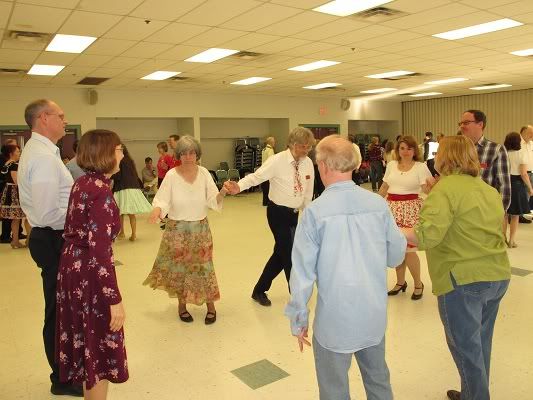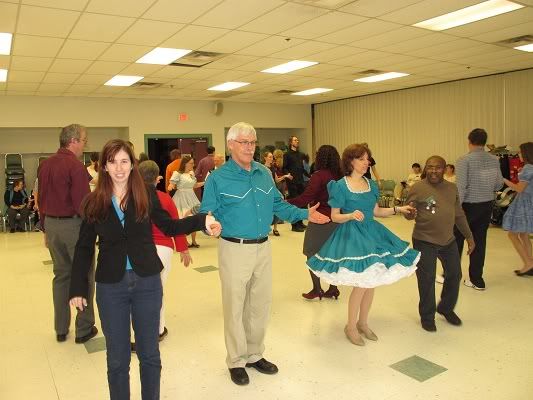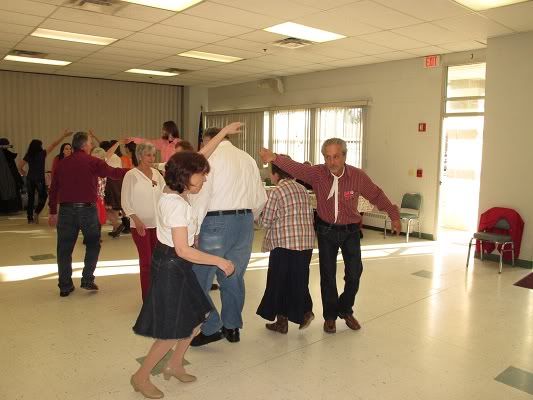Stop reading and get up from the computer.
Okay, fine, read a little bit further, but I'm not joking. Up. Metaphorically, if you use a wheelchair or cane, but how you move doesn't matter as much as how fast. Find or make an empty space at least ten feet by ten feet, and put on some music. It doesn't much matter what music—this activity is traditionally associated with both kinds, country and western, but then there's "Build Me Up Buttercup" (1960s soul), "Moves Like Jagger" (2010s pop), "Mickey Mouse Club March" (1950s Disney), "I Want a Hippopotamus for Christmas"... (Okay, yes, and "Red Solo Cup"; nothing's perfect.) The only requirement is that there be a good beat to the music, a good danceable beat.

Envision[1] yourself positioned (or, better, actually position yourself) in a square, two people per side. The person beside you is your partner, the person catty-corner to you is your corner. The person outside the square with the microphone is the caller, and if something goes wrong it is zir fault. The couple facing the caller and the couple facing that couple are the Heads, the other couples the Sides. Back to the caller? You're couple number 1. Caller to your left? Couple number 2. Continue counterclockwise to couples 3 and 4. The place you're standing now is Home. Oriented? Good.

Join hands and Circle Left. Now Circle Right. Now Up to the Middle and Back.
Welcome to square dancing.
To successfully navigate a square dance tip, you need to remember a few things. Which hand is your left, and which your right? (My father has badges that say "Left" and "Other Left". Just to help people remember. He switches which side he wears them on.) To which number couple do you belong, and does that make you a Head or a Side? Did you start out on the left side of the couple, or the right?
That last is very important to remember; most calls are directed at half the square, though many of them have instructions for both halves, and which half gets the directions varies: Heads or Sides, Centers or Ends, Leaders or Trailers, Left or Right of the couples of the moment, on the left or the right side of Home.
It is typically easier to remember that, when everybody is Home or in normal couples, Boys are on the left and Girls are on the right.
The gender binary pervades square dancing. Genderqueer? Tough; pick one. You can change at the end of the tip, or in the middle if you're dancing with people who don't mind doing two Trades where one was called and possibly confusing the caller and the rest of the square. But there's no 'bigender' or 'agender' or 'third gender' in square dancing. There's boys and there's girls, and every dancer is one or the other.

Note the couple in teal in the foreground. The man is wearing slacks and a Western-cut shirt; the woman, a dress with a circular skirt and a crinoline underneath, and you know they're dancing together because they're wearing the exact same shade of teal. This is traditional square dance attire. A blouse and circle skirt is acceptable in place of a circle-skirted dress, as is a blouse and a prairie skirt. If the dance hasn't been specified to be traditional attire only, no one will bat an eye at a girl showing up in jeans as the redhead on the left did, but if the dance has been so specified, a girl not in a skirt is Frowned Upon. A boy in a skirt is Frowned Upon regardless, but that's not a square-dancing-specific issue.
There's also singing calls. In contrast to patter, where the music is instrumental and the calls are spoken, the calls are sung and so are select lines from the original songs. For instance, in Charlie Daniels's "The Devil Went Down to Georgia", the line "Johnny rosin up your bow and play your fiddle hard" is followed by the line "'Cause hell's broke loose in Georgia and the devil deals the cards". In this singing call version of "The Devil Went Down to Georgia", "play your fiddle hard' is followed by 'Dosado[2], go once around, now Promenade your pard'" (square dancers like rhyme), and then while the dancers are Promenading, the caller sings "If you win you get this shiny fiddle made of gold", which follows "devil deals the cards" in the original. The other relevant point distinguishing singing calls from patter is that in every patter figure, everyone ends up Home. In every singing call figure, the boys go Home while the girls rotate. Because reasons.
Then there's the calls that simply cannot be done in same-sex couples. Swing: like in ballroom dancing, girl's left hand in boy's right, girl's right hand on boy's shoulder, boy's right hand on girl's waist, and rotate clockwise. Star Thru: girl's left hand palm to palm with boy's right, girl steps forward and turns a quarter left to the inside as boy steps forward and turns a quarter right to the outside. Even the calls that don't have gender in the definition are often gendered: to Courtesy Turn, the right-hand side of the couple walks forward and the left-hand side backward in a semicircle so that they end up in each other's footsteps facing the opposite direction. Well, that and some work with the hands. There's no mention in the definition of gender at all. But it is rarely called from same-sex or arky (girl on the left, boy on the right) couples. This is probably because of the hands part of the call: right-hand dancer's left hand in left-hand dancer's left hand, right-hand dancer's right hand on the small of zir back or working her skirt, left-hand dancer's right hand on right-hand dancer's right hand or the small of her back to guide her through her forward motion. For some reason, if it's a girl on the left and/or a boy on the right, people find this awkward.
Courtesy Turn is also an example of one of those things CALLERLAB, the organization that maintains the definitions of all square dance calls, prefers to pretend doesn't happen. In Courtesy Turn from normal couples, he's courtesy-turning her, not the other way around. In California Twirl, he's twirling her. Swing Your Lady is called more often than Swing Your Partner, even though they're the same damn thing. Walk Around Your Corner is exactly what it sounds like: you face your corner and walk around same (distinct from a Dosado Your Corner in that you stay right shoulder to right shoulder the whole move, rather than staying facing a particular wall the whole move), but it's often called as Walk Around the Left-Hand Lady. See Saw, Walk Around Your Corner's counterpart move, is often called as See Saw Your Taw, because square dancers really like rhyme; 'taw' is a word I have never seen outside a square dance context, and it's supposed to mean 'wife'. (Wiktionary says 'spouse' or 'dance partner'; good for Wiktionary. Every time I've been to square dance lessons when See Saw is being taught, I've heard that 'taw' means 'wife', and calling 'See Saw Your Pretty Little Taw' emphasizes that reading. In gender essentialism, men are neither pretty nor little.) In Run, the directed dancers do a half circle into the adjacent inactive dancer's starting position while the inactive dancer steps sideways into the active dancer's starting position, and it can be called as Boys Run, Girls Run, Ends Run, or Centers Run. Of Ends Run and Centers Run, I've noticed that callers don't tend to prefer one over the other, but of Boys Run and Girls Run, guess which one gets called more often?
That's right, it's Boys Run. Little as CALLERLAB likes it, square dancing tends to give the direction to the boys and expect the girls to puzzle out their steps. That's not true of the Ladies Chain family of calls, or of Teacup Chain, but I have never heard Men Chain and rarely Men Teacup Chain, and if the girls are active on those calls then the boys get the easy part. Also rare is Beer Mug Chain, but that is not an official call (not up to Plus level, anyway; I know nothing of Advanced or Challenge) and invariably breaks all the squares. Also notice how, apparently, only girls drink tea and only boys beer.
Boys typically get the easy part with choreography, too. Calls are meant to flow one into another. The call Roll, for example, is meaningless when starting from a static position instead of partway through another call; whichever direction you're turning at the end of the call before Roll, you keep turning that direction another quarter turn. Or Wheel and Deal, then Zoom; in Wheel and Deal, both members of a couple are moving the same direction at the end of the call, and in Zoom, the first part of the call for the leading couple is turn your back on your partner. The boy keeps going in the same direction he was going, while the girl has to halt and reverse direction. This combination is called fairly frequently, generally but not always by male callers who are unfamiliar with dancing the girl's part.
There's also setting up and breaking down the dance hall (moving tables and chairs, etc) and providing the food. Guess which gender, in my experience, typically does which task?
Square dancing isn't all rigid-gender-role doom and gloom. Girls do wear jeans to casual dances, after all.
Square dancers skew female, so to maximize the number of squares on the floor in any given tip, many female dancers dance the male part. And of course dancers who know both parts can switch genders as many times during the night as they like. Not I, if I can avoid it—I find it breaks my brain too badly to be raising the left hand to Star Thru in one tip and the right hand to Star Thru in the next—but my mother and my sisters can dance boy with ease, as can quite a few of the female dancers I know. (My mother, in fact, has made sashes in magenta fleece and sky blue in order to faciliate people changing gender between tips, because she's sick of a tip pausing for the caller to point at one of the seven female-presenting people in the square and ask whether that person's a girl or a boy.) Girls consequently usually win Battle of the Sexes tips, wherein half the squares are all women and the other half all men and the goal is to be in a square that doesn't break down due to somebody doing the wrong half of Star Thru or whatever. On the other hand, when you get the caller interrupting the steady flow of patter to say "[Mama Murasaki], you're a man", you know something's gone wrong.
Then there are LGBT clubs such as Philadelphia's Independence Squares and Washington DC's Lambda Squares. When the expectation that couples in the Home position will be boy to the left girl to the right collides with the expectation that couples in the Home position will be people who arrived together, the latter usually wins.
Dance-By-Definition clubs also exist. CALLERLAB wishes to emphasize (in the introduction to the Basic/Mainstream Definitions file) that "most of the calls are defined without reference to gender", and DBD clubs cheerfully upend the gendered expectations about how these nongendered calls are done. It's in these clubs that you'll hear Courtesy Turn called from same-sex or arky couples, or Teacup Chain called immediately after Half Sashay (which moves couples from normal to arky). It's also members of these clubs who have the least trouble dancing the opposite of their assigned gender.

I love square dancing. I do. One of my local clubs is closing, and I think that's a tragedy. But as I understand it, this was one of the clubs that insisted on traditional attire and mixed-sex couples. Square dancing is changing to match a changing world: casual-dress clubs, LGBT clubs, DBD clubs, and clubs that skew young instead of middle-aged and elderly are proof of that. But I worry that square dancing isn't adapting fast enough, that it can't fully adapt to a world without the gender binary at all, and if square dancing can't fit into a world with no gender binary, then this thing I love deserves to die.
[2] 'Do-si-do' is an oatmeal sandwich cookie containing peanut butter, most commonly sold by Girl Scouts. 'Dosado' is a square dance call. Please do not confuse the two.
I did square dancing in high school and strongly disliked it, but I think that's because of how they taught it. They made the girls pair up with guys and if there weren't any guys you were comfortable dancing with then you just had to deal. I was just awkward about it, but if someone had serious boundary issues, it could be emotionally hurtful to force it on her or him.
ReplyDeleteNow, I know a number of people who square dance, most of whom are "modern hippies." Considering how liberal my area is, I'm guessing most of them would be quite welcoming to same sex or otherwise untraditional couples. In addition, I did participate in a non-traditional céilidh (Gaelic social gathering with dance) when I lived in the UK and it was a lot of fun. I do hope it's a tradition that can evolve into something suitable in the modern world.
Well, yeah, like any other activity on the planet, it's no fun and can pose problems if the person doing it doesn't want to be.
DeleteI hope so too.
Ever hear of contra dancing? Some of the concepts are similar. We go to a couple of these dances a year.
ReplyDeleteI've also taken ballroom dancing lessons, and one thing I noticed was that music for square and contra dancing seems to be in a 16-bar format, while the ballroom format seems to treat all music as one-and-two. During the lessons, I got momentarily confused because I was treating the non-waltz music in 4/4 time, thinking that the steps had to repeat for every measure.
My club's lesson flyers this year actually netted a contra dance couple who were a little confused on the purpose of the flyer.
DeleteI was also going to suggest contra dancing. In my experience small town contras can be somewhat rigid, but the larger festivals are very gender flexible. Dancers are referred to as guys and gals, or men and women, but it's understood that anyone, skirt or no, can play any role. Moreover, it's almost encouraged to switch it up regularly.
ReplyDelete